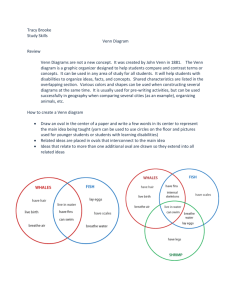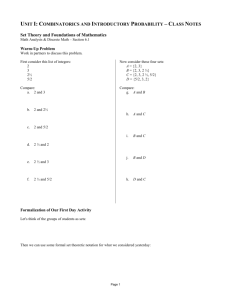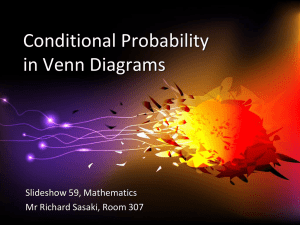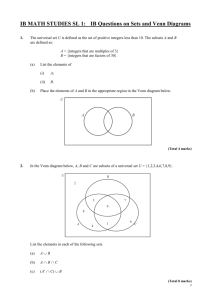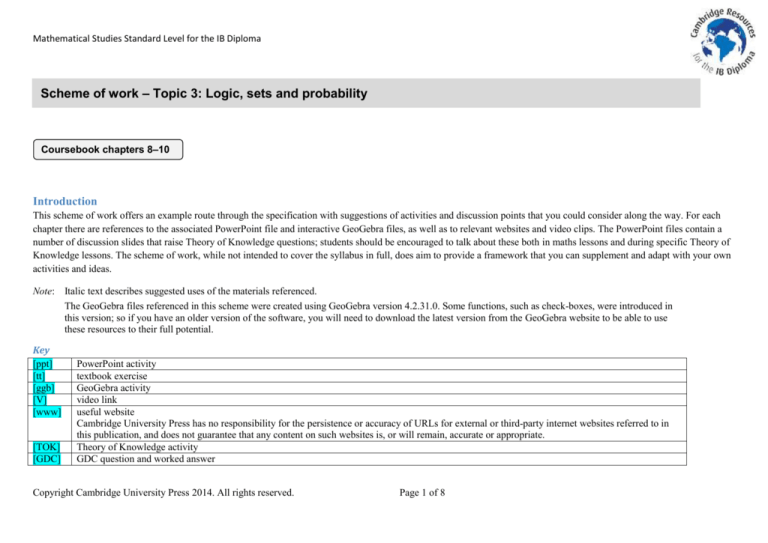
Mathematical Studies Standard Level for the IB Diploma
Scheme of work – Topic 3: Logic, sets and probability
Coursebook chapters 8–10
Introduction
This scheme of work offers an example route through the specification with suggestions of activities and discussion points that you could consider along the way. For each
chapter there are references to the associated PowerPoint file and interactive GeoGebra files, as well as to relevant websites and video clips. The PowerPoint files contain a
number of discussion slides that raise Theory of Knowledge questions; students should be encouraged to talk about these both in maths lessons and during specific Theory of
Knowledge lessons. The scheme of work, while not intended to cover the syllabus in full, does aim to provide a framework that you can supplement and adapt with your own
activities and ideas.
Note: Italic text describes suggested uses of the materials referenced.
The GeoGebra files referenced in this scheme were created using GeoGebra version 4.2.31.0. Some functions, such as check-boxes, were introduced in
this version; so if you have an older version of the software, you will need to download the latest version from the GeoGebra website to be able to use
these resources to their full potential.
Key
[ppt]
[tt]
[ggb]
[V]
[www]
[TOK]
[GDC]
PowerPoint activity
textbook exercise
GeoGebra activity
video link
useful website
Cambridge University Press has no responsibility for the persistence or accuracy of URLs for external or third-party internet websites referred to in
this publication, and does not guarantee that any content on such websites is, or will remain, accurate or appropriate.
Theory of Knowledge activity
GDC question and worked answer
Copyright Cambridge University Press 2014. All rights reserved.
Page 1 of 8
Mathematical Studies Standard Level for the IB Diploma
Topic 3:
Logic, sets and probability
20 hours
Aims: To understand the language of sets and logic and be able to draw conclusions using appropriate reasoning techniques from these fields
To understand the relationship between Venn diagrams, sets and logic
To be able to find the probability of an event using a range of methods of presentation and reasoning, including Venn diagrams
Phase
Chapter 8:
Set theory
and Venn
diagrams
Estimated
time
allocation
4 hours
Focus from
the text
Basic
concepts of
set theory
Learning objectives Activities
Understand the basic
notation used with
sets and Venn
diagrams
Links
[tt] Page 236 Exercise 8.1 ‘Using set notation’
[V] http://www.youtube.com/watch?v=vG
elH3Jibt4&feature=share&list=PL886EA9A1
74ECA1DA
7-minute video defining sets and set notation
[www] http://creately.com/Draw-Venn
-Diagrams-Online
Useful website that lets you make Venn
diagrams (registration not required)
[www] http://www.mathsisfun.com/sets/sets
Venn
diagrams
with
numbers
Be able to answer
questions about sets
from Venn
diagrams;
understand the links
between set
conditions and Venn
diagrams
Copyright Cambridge University Press 2014. All rights reserved.
[ppt] Chapter 8 slides 2–14
This series of slides shows how to represent the empty
set, a subset, an element, complement, intersection and
union using Venn diagrams.
[tt] Page 239 Exercise 8.2 ‘Venn diagrams’
[ppt] Chapter 8 slides 15–16: Summary
Slide 16 shows every combination of two sets (by
linking to slides17–28). Click on an expression to
reveal visually its meaning on the Venn diagram.
Page 2 of 8
-introduction.html
[V] http://youtu.be/NV_tvZ5Mb3k
5-minute video that shows the shading of
various sets and combinations in a Venn
diagram with two sets
Mathematical Studies Standard Level for the IB Diploma
Review of
Chapter 7
1 hour
Venn
diagrams
with three
sets
Understand how to
generalise to three
sets in a Venn
diagram
[tt] Page 245 Exercise 8.4 ‘Venn diagrams with three
sets’
Applications
of set theory
and Venn
diagrams
Be able to relate
Venn diagram
methods to different
situations and
contexts
[tt] Page 241 Exercise 8.3 ‘Applications of Venn
diagrams’
Measures of
dispersion
Secure the skills of
calculating and
using measures of
dispersion by
undertaking past
paper-style
questions
[tt] Page 226 Mixed examination practice
Copyright Cambridge University Press 2014. All rights reserved.
[V] http://www.youtube.com/watch?v=7JF
gPxC_1FI&feature=share&list=PL886EA9A1
74ECA1DA
This 6-minute video shows how to shade
Venn diagrams with three sets.
Page 3 of 8
Mathematical Studies Standard Level for the IB Diploma
Phase
Chapter 9:
Logic
Estimated
time
allocation
Focus from
the text
6 hours
Propositions
Learning objectives Activities
Links
Be able to determine
whether a phrase is a
proposition
[www] http://www.khanacademy.org/math
[ppt] Chapter 9 slides 4–5: Inductive and deductive
logic
Slide 5 gives short examples of deductive and inductive
logic and asks students to consider which is better. As
logic is an abstract topic, it is likely that students will
require time to consider its meaning and applications.
[tt] Page 258 Exercise 9.1 ‘Determining propositions’
Compound
statements
Implication
and
equivalence
Know how to link
propositions
together using logic
connectives;
understand how
compound
statements are
related to Venn
diagrams and set
notation
Understand how
statements can be
related through
implication and
equivalence;
be able to identify if
these relations are
true or false
Copyright Cambridge University Press 2014. All rights reserved.
[tt] Page 264 Exercise 9.2 ‘Writing compound
statements using symbolic notation’
[tt] Page 267 Exercise 9.3 ‘Using implications in
compound statements’
Page 4 of 8
/geometry/logical-reasoning/e
Mathematical Studies Standard Level for the IB Diploma
Using truth
tables
Understand the
construction of truth
tables and be able to
use them to
determine an
outcome
[ppt] Chapter 9 slide 2–3: Problem
Slide 3 presents a logic problem written in words.
Students can discuss the problem in groups, and this
introduces them to the topic of logic through the
process of undertaking logical analysis. Students may
find that they can reason out an answer without using
formal logical methods, but you could use this problem
to introduce truth tables. This activity could easily be
extended by adding other logic problems for the
students to solve in groups and then report back to the
class.
[tt] Page 271 Exercise 9.4 ‘Using truth tables’
[tt] Page 273 Exercise 9.5 ‘Using truth tables to
determine logical validity’
Logical
equivalence,
tautology
and
contradiction
Understand the
[tt] Page 278 Exercise 9.6 ‘ Determining equivalence,
meaning of these
tautology or contradiction using truth tables’
terms and know how
to use a truth table to
determine whether a
statement is one of
these
Converse,
inverse and
contrapositiv
e
Understand the
meaning of these
terms and how they
are related to the
original implication;
be able to determine
which is true
Copyright Cambridge University Press 2014. All rights reserved.
[tt] Page 282 Exercise 9.7 ‘Finding the converse,
inverse or contrapositive’
[ppt] Chapter 9 slides 6–7: Truth table
This provides a summary of the columns of a truth
table, which is also given in the formula booklet and
the coursebook. It would make a good visual display to
help students while they are working on problems.
Page 5 of 8
[V] http://www.youtube.com/watch?v=r6_h
IRYeGq8
9-minute video clip explaining truth tables
Mathematical Studies Standard Level for the IB Diploma
Review of
Chapter 8
1 hour
Set theory
and Venn
diagrams
Secure the skills of
using set notation, set
language and Venn
diagrams by
undertaking past
paper-style questions
Copyright Cambridge University Press 2014. All rights reserved.
[tt] Page 249 Mixed examination practice
[V] http://www.khanacademy.org/math
/probability/independent-dependentprobability/basic_set_operations/v/intersecti
on-and-union-of-sets
8-minute video
Page 6 of 8
Mathematical Studies Standard Level for the IB Diploma
Phase
Chapter 10:
Probability
Estimated
time
allocation
7 hours
Focus from
the text
Learning objectives
Introduction Be able to find the
to probability probability of a simple
event and its complement
Activities
Links
[ppt] [TOK] Chapter10 slides 4–5: Theoretical
versus experimental
This raises the question of whether an event has to
happen and the idea of random events. Using the
Lotto as an example, students can consider a
number of facts and opinions around the strategy
of picking consecutive numbers to try to win. The
web links on the right and on slide 5 provide
interesting background.
[www] http://www.dailymail.co.uk/news
[tt] Page 290 Exercise 10.1 ‘Probability of a simple
event and its complement’
9-minute video
/article-2301360/The-Lotto-numbers-avoidGoing-1-2-3-4-5-6-bring-tiny-windfall.html
[www] http://mathforlove.com/2012/04
/you-will-not-win-the-lottery/
[V] http://www.khanacademy.org/math/pro
bability/independent-dependent-probability
/basic_probability/v/basic-probability
[www] http://www.mathsisfun.com/data
/probability-events-types.html
Sample
space
diagrams
Calculating
probability
and the
expected
value
Understand the different
types of sample space
diagram and be able to
use them to find the
probability of two events
happening
Be able to use probability
to work out the expected
value of an outcome
[tt] Page 293 Exercise 10.2 ‘Probability of two
events using sample space diagrams’
[ppt] Chapter 10 slides 2–3: Gambling ethics
This discussion focuses on the ethical issue of
gambling. Students are asked to discuss the impact
of gambling, not only for pleasure but also within
business and finance. They could consider where
else in everyday life they may gamble, e.g. with
insurance, driving and so on. This discussion could
be used to justify the need for prediction and lead
to the introduction of expected values.
[tt] Page 299 Exercise 10.3A ‘Calculating
probabilities’
Copyright Cambridge University Press 2014. All rights reserved.
Page 7 of 8
[V] http://youtu.be/E4pGo7peiQs
Simple 6-minute explanation of sample
space diagrams
Mathematical Studies Standard Level for the IB Diploma
Mutually
exclusive
events
Probability
of combined
events
Tree
diagrams and
Venn
diagrams
[tt] Page 304 Exercise 10.3B ‘Finding expected
values’
Know when events are
[tt] Page 306 Exercise 10.4 ‘Probability of
mutually exclusive and be mutually exclusive events’
able to find the
probability of their union
Be able to find the
[tt] Page 310 Exercise 10.5 ‘Probability of
probability of combined
combined events, including testing for
events and be able to
independence’
determine whether events
are independent
Be able to work out the
[tt] Page 315 Exercise 10.6A ‘Using tree diagrams’
probability of situations
presented as tree or Venn [tt] Page 317 Exercise 10.6B ‘Using Venn
diagrams
diagrams’
[www] http://www.mathsisfun.com/data
/probability-tree-diagrams.html
[www] http://www.mathsisfun.com/data
/probability-events-independent.html
[www] http://www.mathsisfun.com/data
/probability-tree-diagrams.html
[www] http://www.westfield.ma.edu/ecke
/342/342-Intro-to-Risk.pdf
Review of
Chapter 9
1 hour
[ppt] [TOK] Chapter 10 slides 6–7: Comparing risk
This discussion could be used at the end of the
topic. It asks students to reflect on risks and how
one might determine if a risk is worth taking.
[tt] Page 320 Exercise 10.7 ‘Finding probabilities
in situations of selection with replacement or
without replacement’
Information about the mathematics of risk
and being an actuary
[www] http://www.mathsisfun.com/data
Probability
‘with
replacement’
and ‘without
replacement’
Conditional
probability
Understand the impact of
non-replacement when
considering probabilities
Be able to calculate
probabilities dependent
on certain conditions
[tt] Page 326 Exercise 10.8 ‘Calculating
conditional probabilities’
Logic
Secure the skills of using
logical reasoning by
undertaking past paperstyle questions
[tt] Page 284 Mixed examination practice
Copyright Cambridge University Press 2014. All rights reserved.
Page 8 of 8
/probability-events-conditional.html




